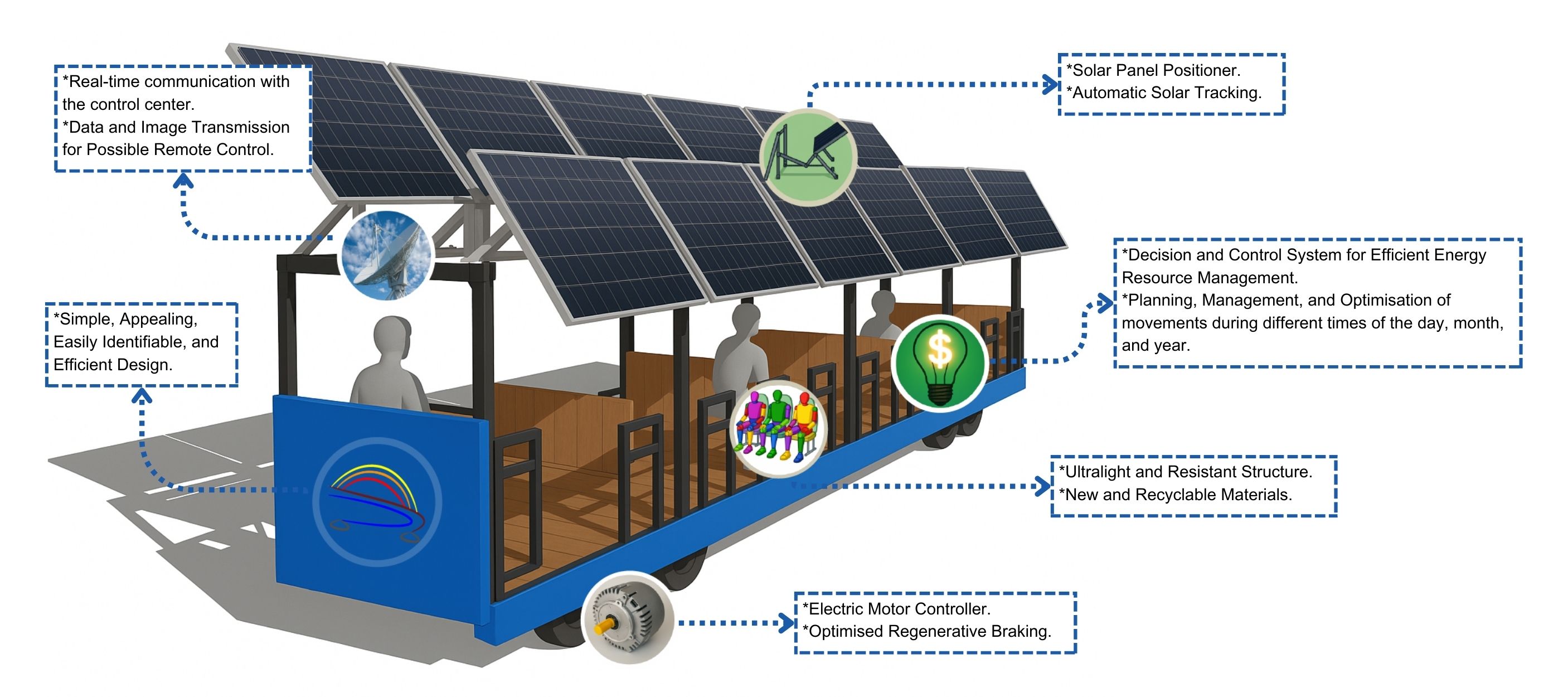Research
Main contributions
This project fosters innovative MSc theses by challenging students
to address cutting-edge engineering problems, bridging academic knowledge with practical application.
By promoting collaborative work across university departments and industry partners, the project creates a dynamic environment that drives innovation and promising outcomes.
The main output will be a scaled railway vehicle powered by photovoltaic panels, demonstrating the feasibility of sustainable rail transport.
Additionally, the project facilitates mutual knowledge transfer between academia and industry, where the MSc students become experienced with real-world challenges and prepare them to launch their engineering careers with confidence.

The background os students are identified with the following list of abbreviations are used:
ECE – Electrical and Computer Engineering;
Phy – Engineering Technology Physics ;
Mec – Mechanical Engineering;
Env – Environmental Engineering;
Civ – Civil Engineering
Key Challenges
The design and development of the scaled solar powered rail vehicle requires addressing a series of 10 Key Challenges (KC), described in the following paragraphs.
- KC1 – Requirements and design brainstorming: Definition of technical project requirements in alignment with current legislation, complemented by a series of alternative draft designs. The outcomes of this KC are not directly addressed in the MSc theses but are intended to provide guidance and direction for the MSc theses associated with the other KCs.
- KC2 – Structural design: The geometry and material of the vehicle frame plays a crucial role on the structural robustness and weight (Hirsch, 2011). This KC aims to provide a design procedure to obtain an optimal design that considers all parts that will be attached to the vehicle main frame, such as, passenger seats, solar panels support, suspension, etc.
- KC3 – Vehicle dynamics design: The stability and comfort of the vehicle as well as the track loading are strongly dependent on the vehicle suspension, wheel and rail profiles, vehicle speed, and track (Iwnicki, 2019). This KC aims to design the suspension configuration and associated components, wheel and rail profiles, among other components relevant for the vehicle dynamics.
- KC4 – Solar panels mechanism: This KC aims to design a mechanism to control the orientation of the solar panels for maximum energy collection (Dimarogonas & Mourikis, 1980), accounting for the vehicle's position and sunlight direction. Additionally, the system's aerodynamic resistance and spatial envelope must be minimized to ensure efficiency and compact design.
- KC5 – Vehicle Propulsion: The selection of the motor and powertrain is pivotal to the vehicle's traction performance, particularly given the challenges posed by steel rolling contact, which can result in low adhesion due to the rigid and small contact surfaces (Lin et al., 2023). Additionally, this KC addresses the choice of wheels for tractive action and traction control algorithm with a focus on minimizing damage to both the wheels and rails (Bosso et al., 2022).
- KC6 – Energy storage: Solar energy supply can be intermittent due to weather conditions, while regenerative braking generates energy in short, high-power bursts (Hosseini et al., 2023). Balancing these inputs requires advanced energy storage systems capable of handling varying power levels, ensuring high efficiency and durability. Furthermore, optimizing the storage capacity to meet the vehicle's energy demands without adding excessive weight or cost is crucial for maintaining performance and sustainability.
- KC7 – Energy management: Effective energy management is essential to ensure the reliable operation of all electrical-dependent systems within the vehicle, including traction motors, braking components and solar panel mechanisms. This involves dynamically prioritizing energy allocation based on real-time demands and available resources (Reddy et al., 2023).
- KC8 – Autonomous driving: Current technologies have matured to support autonomous driving, as demonstrated in some advanced railway networks (Singh et al., 2021). This innovation enhances the user experience and even creates additional passenger space by eliminating the need for a driver’s cabin. This key challenge focuses on integrating advanced sensing technologies, leveraging GNSS receivers for precise vehicle geolocation and range sensors to maintain safe distances between vehicles, all while optimizing journey efficiency. Additionally, machine learning algorithms are addressed to support autonomous driving assistance and logistical optimization of a fleet of railway vehicles.
- KC9 – Economic assessment: While solar technology and energy storage systems may require higher initial investments, they have the potential to significantly reduce operational expenses over time (Ercan & Tatari, 2015). Moreover, maintenance costs can be lower due to the reduced reliance on mechanical components in renewable energy systems. This key challenge focuses on quantifying the economic impact of the proposed concept vehicle, emphasizing its ability to replace conventional road vehicles with high environmental footprints, thereby offering a sustainable and cost-effective alternative for the future.
- KC10 – Aesthetics, comfort and ergonomy: This challenge focuses on creating an appealing and functional design that balances visual attractiveness with practicality. It involves designing the vehicle's exterior and interior to optimize seat layout, enhance the user experience, and ensure cost-efficient manufacturing and maintenance operations (Lanza et al., 2020).
